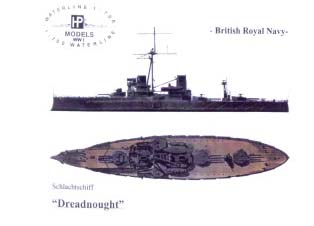HP Models' 1/700 HMS Dreadnought |  | History HMS Dreadnought holds a symbolic place in world history for several reasons. She was the first ship of her kind, bestowing her name on a class of battleship that stretches all the way up to the Iowa, Vanguard and Yamato. She was a revolutionary design produced by a navy that historically shunned revolution. Her new type of engine made her faster than all the other capital ships, and her all-big-gun armament outgunned them, too. When she was launched, every navy in the world was obsolete, including the navy that built her. Finally, she initiated the arms race that ultimately led to World War I. It's rather ironic that the Dreadnought was in port under refit during the Battle of Jutland – the world's largest naval engagement pitting dreadnoughts against dreadnoughts. She does, however, hold the distinction of ramming and sinking a U-boat in 1915. In a twist of fate, it was learned the captain, Otto Weddigen, was the commander of the submarine that had sunk the cruisers Aboukir, Cressy, Hogue and Hawke in 1914. The Kit The kit came to me with the box filled with Styrofoam peanuts and all the parts packed in bubble wrap sleeves. The model made it to Texas all the way from Germany by surface mail with no breakage. The hull piece is nine inches long and nicely cast with no pits or bubbles. It is obvious HP uses an open-face mold for this part because the overpour has been sanded off prior to packing. There is a slight warp with the stern about a millimeter off the surface and the bow about half a millimeter off. This can be fixed with a hot soak in a medium casserole dish filled with near-boiling water. The deck planking and fittings are nicely done. Four resin wafers full of 96 parts make up the rest of the kit--there are no brass or white metal parts included. These parts are well cast, too, with no pits or bubbles. The gun barrels are cast separate from the turrets and will require some sanding to clean up the seam lines. The bulkheads on the superstructure are thin and the detailing is crisp. Although resin parts are included for the lower, tripod, parts of the fore and main masts, the instructions require using aftermarket brass rod to make up the upper parts of the masts. The instructions are printed single-sided on four 8 1/2 by 11" sheets of white paper. Other than the name of the ship and the words "British Royal Navy," the writing is all in German. But, there are only about 35 words of text anyway, which are easy to translate into English. The first sheet has black and white side and top views of the Dreadnought as she was in 1907; the second sheet an exploded view of the assembly with a detail scrap view of the boat stowage arrangement; the third sheet a diagram of how to assemble the masts; and the final page color side and top views of the ship. The biggest disappointment is that the kit comes without a provision for the torpedo nets and booms, which were a prominent part of her profile in 1907 and are even illustrated in the black/white and color drawings in the instructions. Conclusion This is a well-cast model that should be a rather straight-forward build – except for the torpedo net problem. The booms will be easy to replicate with brass or styrene rod, but representing the torpedo net stowage, shelf and davits will be challenging. Although torpedo nets were removed during World War I, the foretop and main mast were substantially different than that depicted in the kit, requiring an even more challenging scratch-build project than torpedo net problem would require. | 








|